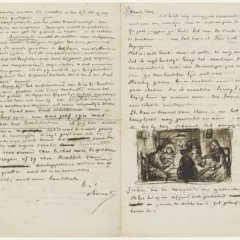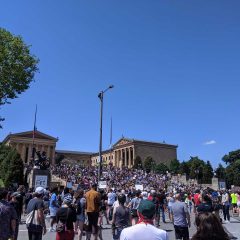This week’s Weekly has my review of the PMA’s new Notations installation in the Contemporary Art Galleries. It also has some additional newsy bits from the museum and a paragraph I’m re-inserting here that was cut from the Weekly story. The piece is based on an interview I had with Curator of Contemporary Art, Carlos Basualdo, in which we walked through the museum and talked about the works. Here’s the link to the art page. And here’s Libby’s post on the installation.
Putting in a Good “Words”
The PMA’s contemporary art curator unveils his installation.
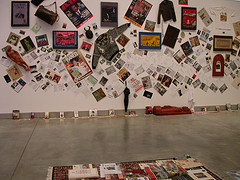
Georges Adeagbo, Abraham Friend of God, installation detail. The piece anchors the new Notations installation, Out of Words, in PMA’s Contemporary Galleries. It’s impossible to capture the entirety — 4 walls and a floor filled with objects — with one photo
Carlos Basualdo’s new installation “Out of Words” is the second in his “Notations” series, in which the PMA’s curator of contemporary art dips into the museum’s holdings and pulls out art and objects that tell a more diverse, global story about contemporary art than is usually taught in history books or seen in museums.
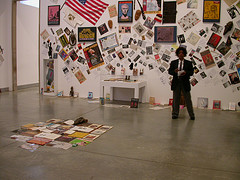
Another wall. The installation is chapel-like, each wall is a separate altar.
As with “Energy Yes!”, Basualdo’s first installation, “Out of Words” is anchored around a prominent new acquisition: Georges Adéagbo’s Abraham, Friend of God—a sprawling accumulation piece that brings together everyday materials like newspapers, empty cigarette packages, thrift shop items, the artist’s handwritten notes, bottles, cans, books, photos and some paintings and wood carvings. (There’s a great Liberty Bell carving.)
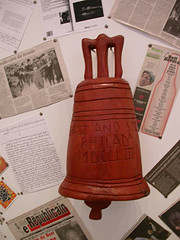
Liberty Bell carving done by carvers in Adeagbo’s home town in Benin.
Basualdo says Abraham is the first large piece of African art in the collection.
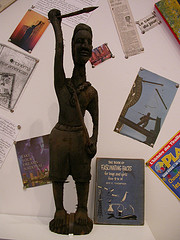
Detail, warrior with spear, construction worker with I-beams and book of fascinating facts. Reading your way through the piece is like being on a stream of consciousness ride through issues in pop culture, thought, art and life.
Adéagbo commissioned artists from his hometown in Benin to make the paintings and carvings. The large 30-by-30-foot installation (which refers both to the biblical Abraham and to Abraham Lincoln) is chapel-like, with each wall becoming a separate theme or altar. The focus is on freedom, liberty, democracy and speech. Two rugs on the floor evoke prayer rugs, but they’re covered with books and rendered unusable. It’s downright overwhelming, but if you pay close attention and read the walls, the many nice allegiances add up to a larger story.
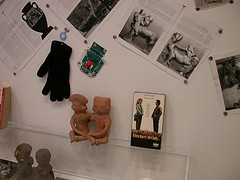
When Harry Met Sally and the ceramic totem of a couple. Love among the icons.
Adéagbo, who studied law in Paris before being called home to take care of the family after his father’s death, turned to art in the aftermath of a breakdown. The self-taught artist is a visionary, and his obsessive arrangement at the PMA is manic, self-assured and a little messy—like much visionary art. It’s also a great piece that speaks of the entwined lives of all whose thoughts pingpong like the papers in this piece. We worry about war and hope for beauty and a little humor. We pray, drink, live, work and raise our children in an uncertain world.
In July Basualdo’s third “Notations” show opens—a painting exhibit with works by Gerhard Richter, Sigmar Polke and Anselm Kiefer (including his huge 1984 straw-covered canvas Nigredo). The show will include some work on loan as well as pieces from the PMA’s collection that have never been seen before.
[Paragraph cut from the Weekly story]
I asked whether he was doing anything with local artists and Basualdo said, “That depends on what you mean by local,” telling me about an exhibit he’s organizing of works by Barbara Chase-Riboud, a former Philadelphian and Tyler grad perhaps best known for her 1979 novel, Sally Hemings.
Basualdo has also been involved in the purchase of some contemporary photography, including Candida Höfer’s Igreja de São Francisco de Assis, Salvador, Bahia III—a piece that harks back to the altars seen in the recent “Tesoros” exhibit, and that’s now on view in the South Auditorium corridor.
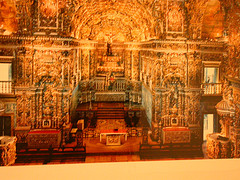
Candida Hofer photo of the Bahia church (sorry for the fuzzy picture). Amazing gold leaf in this altar. Great strip of blue running through the picture due to light coming through one of the windows.
And he’s reawakened the program in the video gallery, showing a series of short conceptual pieces by Romanian-born artist Mircea Cantor. The hallway outside the video gallery—enhanced with much-needed lighting—has a sampling of Cantor’s paintings, drawings and sculpture that have transformed the space from a drab hallway into a destination.
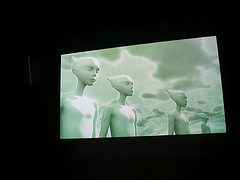
Mircea Cantor video, Zoooom, in the newly-christened, Live Cinema program in the video gallery. The piece has to do with the pyramid on the dollar bill and a group of aliens who disassemble the pyramid and walk away with the stones hovering over their heads.
Carlos Basualdo speaks TODAY on: “Tropicália: Revolution in Brazilian Culture”. Wed., Jan. 17, 4:30pm. Free. University of Pennsylvania, Meyerson Hall B-3, 210 S. 34th St. 215.888.8374.
“Out of Words” Through May. Philadelphia Museum of Art, 26th St. and the Pkwy. 215.763.8100.



